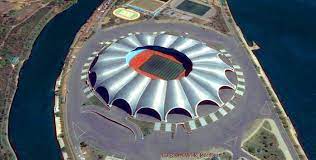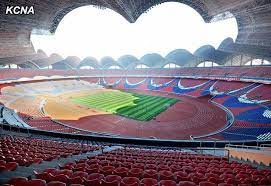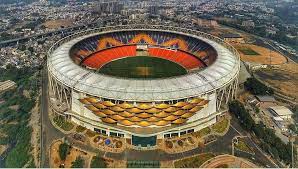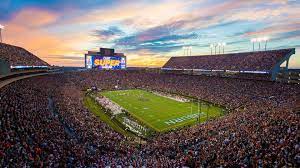The World Largest Stadium in the world

Rungrado Stadium:
Rungrado 1st of May Stadium, also known as the Rungrado May Day Stadium, is a colossal sports stadium located in Pyongyang, the capital city of North Korea. It is one of the largest stadiums in the world and is primarily used for national and international sports events, as well as large-scale performances and political gatherings. Here are some key facts about the stadium:

-
Size: The Rungrado Stadium has an impressive capacity of approximately 150,000 spectators, making it the largest stadium in the world by seating capacity.
-
Construction: The stadium was constructed from 1986 to 1989 and was officially opened on May 1, 1989, to commemorate International Workers' Day, also known as May Day, which is celebrated in North Korea as a major holiday.
-
Design: The stadium's design is distinctive, featuring a unique scalloped roof that resembles a magnolia blossom or parachute. It was built this way to evoke the image of a flower, which is a symbol of beauty in Korean culture.
-
Purpose: While the stadium hosts various sporting events, including football matches and athletics competitions, it is also frequently used for large-scale performances and mass games, which are highly choreographed events that showcase the country's achievements and ideology.
-
Mass Games: The stadium is particularly famous for hosting the Arirang Mass Games, a spectacular event that involves thousands of performers, dancers, and gymnasts coming together to create intricate and colorful displays, often accompanied by music and elaborate props. The games were held periodically, showcasing North Korean culture, history, and national pride.
-
Political Events: The stadium is a significant venue for political gatherings and events in North Korea. It has been used for major celebrations and rallies, including military parades and ceremonies.
-
Tourism: The stadium is open to foreign tourists on selected occasions, and visitors have the opportunity to attend sports events or cultural performances held at the venue.
-
Surroundings: The stadium is situated on an island in the Taedong River, adding to its scenic setting and prominence in the Pyongyang skyline.
As with many aspects of North Korea, reliable information can be limited due to the country's secretive nature. However, Rungrado Stadium remains an iconic landmark and symbol of North Korean national pride and sporting prowess.
Narendra Modi Stadium:
Narendra Modi Stadium is a cricket stadium located in Ahmedabad, Gujarat, India. It was formerly known as Sardar Vallabhbhai Patel Stadium or Motera Stadium before being renamed in honor of Narendra Modi, who served as the Chief Minister of Gujarat before becoming the Prime Minister of India.

Capacity: After undergoing a massive renovation and reconstruction, the stadium's seating capacity was increased to over 110,000 spectators, making it the largest cricket stadium in the world in terms of seating capacity.
-
Renovation: The stadium underwent a significant redevelopment project, which was completed in early 2020. The renovation included the demolition of the old stadium and the construction of a new, state-of-the-art facility.
-
Facilities: The revamped Narendra Modi Stadium boasts world-class amenities, including modern seating, advanced broadcasting facilities, practice grounds, and cutting-edge infrastructure.
-
Home Ground: The stadium is the home ground of the Gujarat Cricket Association (GCA). It hosts domestic cricket matches, international cricket fixtures, and various other sporting events.
-
Day-Night Tests: The stadium has hosted some historic cricket matches, including the first-ever day-night Test match in India. The third Test match between India and England in February 2021 was played under lights with a pink ball.
-
Multi-Purpose Venue: In addition to cricket, the stadium is designed to host various other sports, cultural events, and functions. It can accommodate a wide range of activities due to its massive capacity and versatile facilities.
It's worth noting that the status and information about various places, including stadiums, can change over time. It is recommended to check for any updates or recent developments regarding the stadium's status or events if you are planning to visit or attend any matches or functions there.
Jordan–Hare Stadium:
Jordan–Hare Stadium is a football stadium located on the campus of Auburn University in Auburn, Alabama, United States. It serves as the home venue for the Auburn Tigers football team, which competes in the NCAA Division I Football Bowl Subdivision (FBS) and the Southeastern Conference (SEC). Here are some key details about Jordan–Hare Stadium:

-
Capacity: As of my last update in September 2021, the stadium's official seating capacity was around 87,451 spectators, making it one of the largest college football stadiums in the United States.
-
History: The stadium was originally known as Cliff Hare Stadium when it opened in 1939. It was later renamed in 1973 to honor Ralph "Shug" Jordan, Auburn's football coach from 1951 to 1975, who had a significant impact on the university's football program.
-
Expansion: Over the years, Jordan–Hare Stadium has undergone several expansions and renovations to increase its seating capacity and enhance its facilities. The most recent major expansion occurred in 2004, which further increased the stadium's capacity.
-
Rivalries: The Auburn Tigers have several intense rivalries, and Jordan–Hare Stadium is the venue for some of the most anticipated college football matchups in the country. Notably, the annual Iron Bowl game against the University of Alabama, held in odd-numbered years, is one of the most heated and storied rivalries in college football.
-
Auburn Traditions: The stadium is known for its passionate and loyal fanbase, who actively participate in various Auburn traditions, including the "War Eagle" battle cry, the "Tiger Walk" where the team walks through the fans before each game, and the singing of the "Auburn Alma Mater" after each home game.
-
Events: Apart from football games, Jordan–Hare Stadium has hosted other events, including concerts, commencement ceremonies, and other special occasions.
As with any stadium, it is essential to check for updates on capacity, events, and other relevant information since these details might change over time. If you're planning to attend a game or visit the stadium, it's best to consult the official Auburn University Athletics website or relevant sources for the latest information.








